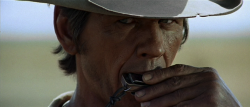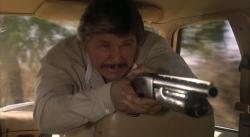Reviews
André de Toth
USA, 1953
Credits
Review by Rod Bastanmehr
Posted on 10 November 2011
Source Warner DVD
Categories BRONSON!
Charles Bronson had yet to become Charles Bronson in 1956’s House of Wax. This is true both figuratively and literally, as he is credited as Charles Buchinsky in the film. (He later changed it at the height of the Red Scare for fear that studios and politicians might find him too Eastern European.) Bronson’s role in House of Wax, while understated and lacking in screen time to the point of non-existence, still manages to play key in this André de Toth-helmed remake of 1933’s Mystery of the Wax Museum (which was also dismally remade in 2005). Whereas the latter was a foray into expected slasher tropes, de Toth’s film falls more in place with Britian’s early-melodramas, finding ties with Gainsborough pictures more so than the Hammer films.
The film—a certifiable B-movie—is delightfully paced, and we move quickly and eagerly across the landscape of early twentieth-century New York. Here, Vincent Price (ever eccentric) is Professor Henry Jerrod, a sculptor whose museum features wax figures of famous faces throughout history. His chronic concern is maintaining elegance, and staying true to the beauty of his “children,” his delightfully eerie yet lonesome pet name for his figures.
In some of the film’s opening bits of dialogue, Price’s Professor Jerrod speaks to his museum’s sole investor, Matthew Burke (Roy Roberts), lamenting their differing views of what draws an audience and, thus, a profit:
“There are people out there who want beauty,” says Jerrod.
“They want shock, sensation, the morbid,” says Burke.
Perhaps they do. Perhaps Burke is right, and perhaps he predicts an audience’s desire before they can even pinpoint it themselves. But Burke doesn’t wait around long enough to find out, burning the museum (and the professor down with it) in an effort to collect the insurance sum of a failed business that preaches “beauty” over profit.
Once we flash forward an undisclosed amount of time, we see a web of characters begin to connect: Burke wooing Cathy (Carolyn Jones), a sweet blonde whose good friend and roommate, Sue Ellen (Phyllis Kirk), begins to suspect fowl play when both Burke and Cathy wind up dead, their bodies vanishing mere hours after being brought into the morgue. At this same moment, Professor Jerrod reappears, with a trusty mute assistant (Charles Bronson) in tow, looking for a new investor for a museum that promises the shocking and morbid sensation Burke desperately wanted. Here, Jerrod recreates the “children” Burke burned down: William Kemmler, the first person ever executed in an electric chair, whose wax figure resembles his former investor; and a Joan of Arc [that looks all too similar] to Cathy, down to a pierced ear. But it’s Jerrod’s quest for his new Marie Antoinette—his prized possession—that leads him down his most insidious path.
House of Wax is at its core a minor film, both in the resumé of its stars and its place in the genre. It is, of course, Price’s film, as all films featuring the late actor irrevocably become his, his ownership, his to command. But it’s Bronson’s physical presence that is most perfectly utilized. What made Bronson such a unique actor was his look, his actual physical appearance that would alter the scene and bring in a sort of understated surreality mixed with overt machismo that would, later in his career, become his calling card. When that exaggerated brow-bone was on screen, Bronson was all you would see.
House of Wax’s strange discourse surrounding creations of beauty, stardom, and “something an audience wants to see,” gives Bronson’s screen debut an interesting context. In fact, the film itself stands as less an exercise in genre and more a chapter of the cinema symbolic. As the industry was in a state of transition (moving away from the traditions of a dying studio system), horror also found itself on the precipice of transition, a shift from the sentimental to the sensational—a return, perhaps, to its roots in the phantasmagoric shows of yesteryear, firmly founded in escapism and heightened reality, though a reality still recognized. House of Wax’s opening shot, the silhouette of a woman holding a butcher knife, presumably hovering over the body of a man sleeping who would in moments no longer be sleeping (nor breathing if we’re to go there) speaks volumes: the film begins at the genesis of the “motion picture,” continues onto horrific attempts at duplicating the living and the breathing, and ends, (both on screen and off) in an entirely new dimension.
Moreover, the years preceding (and directly following) the release of House of Wax created the industry’s most overt line to denote past and present, by ridding the studios of the infamous Hayes Production Code. The code—which was implemented in the early 1930s and intensified during the political paranoia of the mid-1940s to the mid 1950s—created a stalemate between the creative class and the industrial heads. It was finally dissolved with the creation of the MPAA in the late 1950s. In 1953, however, a transition was already taking place, in which the formula of the silver screen was slowly deteriorating, and in its place was coming a new movement to give audiences something more audacious.
“There are people out there who want beauty.”
“They want shock, sensation, the morbid.”
In this way, House of Wax stands as both spectacle and statement, a work of profound timeliness and wry self-reflexivity, while also standing firmly as the kind of work Price loved the most: lowbrow horror that allowed his unique mannerisms to become not merely a prop but rather the point entire.
Bronson’s is a minor part, taking over the roll of an Igor substitute (named, appropriately, Igor) to Price’s vaudevillian Frankenstein. It cements the film’s more abstract connection to that 1931 Universal picture, and its depiction of creation, catastrophe, hell, humanity, monsters and men, and creation itself. But whereas the original utilized the expectancy of an audience still succumbing to the birth of “the talkies,” House of Wax presents a similar entryway into cinema’s next model, more specifically the advent of 3D.
In seeing the film now (and now is perhaps the best time to review it, considering both the recent surplus of 3D releases and its inevitable, predictable even, fall into immediate irrelevance), the effects are mockingly artificial; subtlety in showing-off novelties seems a decidedly present-day trait, and even that remains arguable. The film’s cinematography is more fluid than anything of the era, moving about with such ease and flow that when the camera lingers, allowing its longshots to establish tension, one just wants for it to move again; a dance with death.
But never before have characters felt the need to throw things at the forth-wall as unassumingly, yet giddily, as they do in House of Wax. This is only confirmed in the two-minute long paddleball sequence, in which an entertainer stands outside of Professor Jerrod’s newly opened museum dazzling the crowd with his tri-paddleball action, and simultaneously dazzling an audience newly immersed in 3D, and fully embracing the vision of post-code filmmaking where balls are allowed to fly in their face, and they’re allowed to hoot and holler at it.
What makes House of Wax work, both as a film within the genre and Bronson’s own oeuvre, is this almost metatextual regard of changes within the industry, within the audience, within the expectancy of art, commerce and the very act of spectatorship itself. If the film posits these topics loosely, it does so rather unknowingly. Let us view Bronson’s role in this film as something more than a preliminary to a notable career, and in doing so let us forgo the simple analysis that besets an actor’s earlier works, because with film in a state of transition, Bronson’s role as an aide in a new freakshow of flesh and prosthesis is simultaneously vital in seeing his career progress. Igor, a bizarrely figured man, aids a new form of entertainment and escapism, and in doing so Bronson metaphorically lays the land for the industry that he would uniquely command from the sidelines.
Consider House of Wax as both Bronson’s introduction into the world of genre, as well as a picture with presages of a changing industry and a burgeoning career. The film is a symbolic beginning, of both Bronson and Hollywood’s new life as uninhabited, uninhibited, and unstoppable. The wax of Production Code-era has peeled; long live the new flesh.
More BRONSON!
-

10 to Midnight
1983 -

Mr. Majestyk
1974 -

Once Upon a Time in the West
1968 -

The Evil That Men Do
1984 -

Farewell, Friend
1968 -

House of Wax
1953
We don’t do comments anymore, but you may contact us here or find us on Twitter or Facebook.



